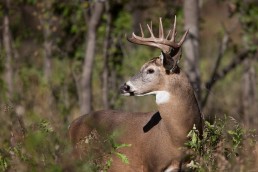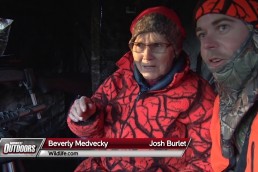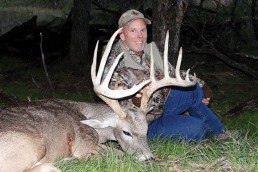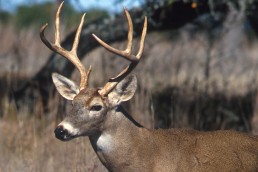Dead Deer Do Talk
SHARE THIS POST
If you’re lucky enough to get a deer this fall, don’t be overly hasty in gutting and dragging it out. That deer has a lot to tell you about its habits and lifestyle that can be invaluable for getting its “older brother.”
Burrs and such are a bother on you and your dog, but they are a fact of life to deer and are probably just ignored. To you they can be a clue as to where that deer has actually been. Learn the seeds of different “burr” plants and where they grow and you have a clue to where to look for deer. Cocklebur, for example, grows in newly disturbed areas such as along field edges. Sunflowers on the other hand are perennials. These some years can get big enough to produce seeds, so look for long abandoned fields. Sand burr are a pain—literally—to you and your dog, and probably likewise for a deer. Sand burrs tend to grow in recently disturbed or bare soil and don’t compete with other grasses very well. The presence of sand burr seeds around the lower legs might indicate that the deer walked along a field edge or a tractor lane.
The head of a deer is full of clues to its activities. Scars around the nose and notches on the ears tell of dueling activity. Bucks don’t lock antlers unless they have to, and only do so with bucks that are relatively equal in size. New scars tell you that that other deer is still around. Older scars may indicate that you got the big one for the area and that next year you might want to widen your scouting into the territory of another dominant buck.
Antlers become lighter from sunlight, so light-colored ones usually mean that the buck spent a lot of time in open fields feeding, fighting or both. Since deer don’t like busy places, this might indicate an isolated field that is waiting to be found. Darker antlers means the buck liked the shadows of the woods and/or is very nocturnal. Its antlers may also give a clue as to where it likes to spend its time, and a deer with lighter-colored antlers means you might have a better chance at seeing him during the day than one that has dark antlers.
Hoofs can help determine whether a buck was running on rock or slipping through soft sand. Scarred up hoofs and shins mean rock. Also, missing hair along its back might indicate a fence that was regularly crawled under. This area can be a good place for a treestand, especially if you’ve found cockleburs and you saw a field with these plants nearby.
Are you enjoying this post?
You can be among the first to get the latest info on where to go, what to use and how to use it!
Look through the gut pile to see what he’s been feeding on. Easily recognized items were just eaten within 24 hours or so. Corn and soybeans are almost a given, but look for things like apple seeds. Todays corn is high in carbohydrates but low in proteins, as it has been bred for the production of corn syrup.
Deer often need to find another food source for protein, and nuts are just that. Oaks are the best, and are probably highest on the preference list for them, but if there is a lack of acorns you might find other seeds in a deer’s gut. Deer will also eat oak, cherry, walnuts, red pines, maple and white pine. If your hunting and scouting area lacks easily accessible crop foods, evidence of these others will help you know where to look next year.
Bucks also browse on shrubs such as elderberry, plum, chokecherry, dogwood and hawthorn. While it might be difficult to find any recognizable remains of these plants in a deer’s stomach, it just makes good sense to see what you can see. Certain seeds might give a certain color to the stomach contents too. For example, a winter berry will give a red cast while cherry or elderberry will have a bluish-black tint.
Sure, the deer was eating corn, but there might be lots of cornfields nearby. You also have to consider if there were cockleburs along the sides. Are there any “special” or unique foods? I’m sure that deer, like humans, have their mainstay nutritious foods and then they have their dessert. Maybe you can identify an out-of-the-way food source that is their “ice cream.”
After the shot is a good time to piece together the history of your animal. Will any one of these things tell you exactly where to find next year’s buck? No. However, each bit of information can add to your encyclopedia of deer knowledge, contribute to the whole hunting experience and can hopefully help you get an even big buck this fall or the next year.
MWO
SHARE THIS POST
Did you enjoy this post?
You can be among the first to get the latest info on where to go, what to use and how to use it!
Doug Thalacker
Doug Thalacker has a Masters of Environment Science from UW-SP and taught high school environmental science and earth science. He has outdoor/wilderness training through Outward Bound and American Red Cross. He has a lifetime of enjoying any activity that involves fields, woods or waters.



